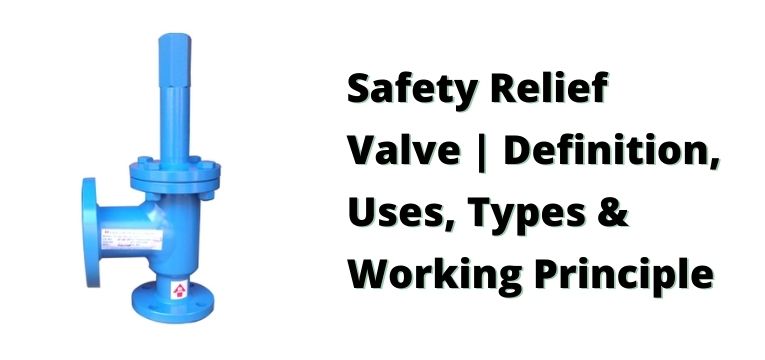Safety Relief Valve
A Safety Relief Valve is a device installed in a pressurized system to protect it from overpressure. The valve is designed to open automatically and discharge excess pressure, thereby preventing damage to the system or potential harm to people and equipment. The discharge capacity of the valve is set to a predetermined pressure, typically above the maximum working pressure of the system, to ensure that it opens only when necessary. Safety relief valves are commonly used in industrial, marine, and power-generating applications.
Why We Use Safety Valve?
Safety valves are used in pressurized systems to ensure the safety of equipment and personnel. The main reason for using safety valves is to prevent overpressure in the system, which can cause damage to the system components, lead to leaks, or even result in an explosion. Additionally, safety valves can help prevent harm to people who may be working near the pressurized system. In some cases, safety valves are also used to comply with government regulations or industry standards, which require their use as a safety measure. Overall, the use of safety valves is crucial in ensuring the safe and reliable operation of pressurized systems.
Safety relief valves are used in a variety of pressurized systems, including:
1. Industrial applications: Used in boilers, pressure vessels, pipelines, and other industrial equipment to prevent overpressure.
2. Marine applications: Used on ships, boats, and offshore platforms to prevent overpressure in fuel, hydraulic, and other pressurized systems.
3. Power-generating applications: Used in power plants, including steam boilers, to prevent overpressure in the steam system.
4. Petroleum and gas applications: Used in the petroleum and natural gas industry to prevent overpressure in pipelines and storage tanks.
5. Aerospace applications: Used in aircraft and spacecraft to prevent overpressure in fuel, hydraulic, and other systems.
Overall, safety relief valves are used to protect pressurized systems and prevent overpressure, ensuring the safe and reliable operation of these systems.
Types Of Safety Relief Valves
There are several types of safety relief valves, including:
1. Pressure Relief Valves: The most common type of safety relief valve, used to protect systems from overpressure. They open when the system pressure exceeds a predetermined set point.
2. Temperature Relief Valves: Used to protect systems from overheating, these valves open when the temperature exceeds a set point.
3. Vacuum Relief Valves: Used to protect systems from vacuum conditions, these valves open to admit air into the system when the pressure falls below a set point.
4. Combination Relief Valves: These valves provide both pressure and temperature protection in one device.
5. Pilot-Operated Relief Valves: These valves use a small pilot valve to control the main valve, providing more precise pressure control.
6. Rupture Discs: These devices consist of a thin metal disk that bursts at a predetermined pressure, providing overpressure protection.
7. Relief Valves with Accumulators: These valves are used in hydraulic systems to prevent overpressure by using an accumulator, which stores excess fluid and releases it back into the system when needed.
Each type of safety relief valve is designed for specific applications, and choosing the right valve depends on the specific needs of the system.
Working Principle Of Safety Relief Valve
The working principle of a safety relief valve is based on the principle of pressure balance. The valve is designed to open automatically when the pressure in the system exceeds a predetermined set point. The set point is determined by the valve’s spring force and is usually higher than the normal operating pressure of the system.
When the pressure in the system increases, the increased force acting on the valve’s disk overcomes the spring force and causes the disk to lift off its seat. This allows excess pressure to escape through the valve’s discharge outlet. Once the pressure in the system returns to a safe level, the spring force closes the disk, stopping the discharge of fluid.
The valve is designed to reseat tightly, preventing any leakage of fluid when the pressure is within the safe range. The spring force can be adjusted to change the set pressure of the valve, allowing it to be calibrated to the specific needs of the system.
Overall, the working principle of a safety relief valve is simple and effective in providing overpressure protection for pressurized systems, ensuring the safety and reliability of these systems.
Fidicon Devices India Manufacturer Of Safety Relief Valves In Gujarat, India
Application Of Safety Relief Valve
Safety relief valves are used in a wide range of pressurized systems, including:
1. Boilers and steam systems
2. Pressure vessels
3. Pipelines
4. Industrial equipment
5. Offshore platforms and ships
6. Power plants
7. Petroleum and natural gas systems
8. Aerospace systems
9. Hydraulic systems
10. Chemical and petrochemical plants
In each of these applications, safety relief valves are used to prevent overpressure, ensuring the safe and reliable operation of the system. They are critical components in many industries, providing an important layer of protection for equipment, personnel, and the environment. The specific requirements of each application, such as the set pressure and flow rate, determine the type of safety relief valve needed to ensure safe and effective operation.
Fidicon Devices India Manufacturer & Supplier of All Types of Pressure & Safety Relief Valves, Pressure Relief Valves, Back Pressure Relief Valve & Emergency Relief Valve, in Ankleshwar, Dahej, Bharuch, Gujarat, India.
